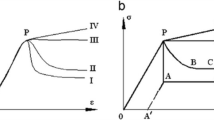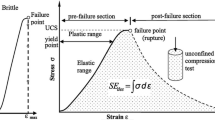Abstract
The penetration rate of tunnel boring machine (TBM) is an important factor in cost and time estimation of excavation operations for project planning and choice of economical tunneling methods. Several methods are used to predict this parameter such as experimental, empirical, and analytical methods. In this study, a new empirical method is proposed to predict the penetration rate of TBM using the actual data of Karaj-Tehran water conveyance tunnel in Iran. It is predicted based on the post-failure residual strain energy to the pre-failure stored strain energy (named strain energy ratio) and the equivalent thrust per cutter. The result shows that there is a direct relation between the penetration rate of TBM and the strain energy ratio, and an inverse relation between the penetration rate of TBM and the equivalent thrust per cutter. In this study, a new polynomial equation is proposed to predict the TBM penetration rate based on the strain energy ratio. Also, a new linear equation is suggested to predict the equivalent thrust per cutter using of the strain energy ratio. Finally, the most useful equation to predict the penetration rate of TBM is achieved using the equivalent thrust per cutter and the strain energy ratio because it is a function of both parameters.










Similar content being viewed by others
References
Alber M (1996) Prediction of penetration and utilization for hard rock TBMs. In: Baria M (Ed.), Prediction and Performance in Rock Mech. and Rock Eng. Torino. Balkema, Rotterdam, 2:721–725
Alejano LR, Rodriguez-Dono A, Alonso E, Fdez-Manin G (2009a) Ground reaction curves for tunnels excavated in different quality rock masses showing several types of post-failure behavior. Tunn Undergr Sp Tech 24(6):689–705
Alejano LR, Alonso E, Rodriguez-Dono A, Fernandez-Manin G (2009b) Application of the convergence-confinement-method to tunnels in rock masses exhibiting Hoek–Brown strain-softening behaviour. Int J Rock Mech Min Sci 47(1):150–160
Cai M, Kaiser PK, Uno H, Tasaka Y, Minami M (2004) Estimation of rock mass deformation modulus and strength of jointed rock masses using the GSI system. Int J Rock Mech Min Sci 41(1):3–19
Cai M, Kaiser PK, Tasakab Y, Minami M (2007) Determination of residual strength parameters of jointed rock masses using the GSI system. Int J Rock Mech Min Sci 44(2):247–265
Farmer IW, Glossop NH (1980) Mechanics of disc cutter penetration. Tunn Tunn 12(6):22–25
Gong QM, Zhao J (2007) Influence of rock brittleness on TBM penetration rate in Singapore granite. Tunn Undergr Sp Tech 22(3):317–324
Graham PC (1976) Rock exploration for machine manufacturers. In: Bieniawski ZT (ed) Exploration for rock engineering. Balkema, Rotterdam, pp 173–180
Hoek E, Brown ET (1997) Practical estimates of rock mass strength. Int J Rock Mech Sci Geom Abstr 34(8):1165–1186
Hoek E, Diederichs MS (2006) Empirical estimation of rock mass modulus. Int J Rock Mech Min Sci 43(2):203–215
Hoek E, Carranza-Torres C, Corkum B (2002) Hoek–Brown failure criterion–2002 edition. In: Bawden HRW, Curran J, Telsenicki M (eds) Proceedings of the North American Rock Mechanics Society (NARMS-TAC 2002). Mining Innovation and Technology, Toronto, pp 267–273
Hoek E, Carranza-Torres C, Diederichs MS, Corkum B (2008) Kersten lecture: Integration of geotechnical and structural design in tunnelling. Proceedings University of Minnesota 56th Annual Geotechnical Engineering Conference, Minneapolis, pp 1–53
Khademi Hamidi J, Shahriar K, Rezai B, Rostami J (2010) Performance prediction of hard rock TBM using Rock Mass Rating (RMR) system. Tunn Undergr Sp Tech 25(4):333–345
Mansouri M, Moomivand H (2010) Influence of rock mass properties on TBM penetration rate in Karaj-Tehran water conveyance tunnel. J Geol Min Res 2(5):114–121
Marinos P, Hoek E (2000) GSI: a geologically friendly tool for rock mass strength estimation. Proceedings of the GeoEng2000 at the international conference on geotechnical and geological engineering, Melbourne, Technomic publishers, Lancaster, pp 1422–1446
Nelson P, O’Rourke TD (1983) Tunnel boring machine performance in sedimentary rocks. Report to Goldberg-Zoino Associates of New York, P.C., by School of Civil and Environmental of Civil Engineering. Cornell University. Geotechnical Engineering Report 83-3, Ithaca, p 438
Palmström A (1995) RMi- a rock mass characterization system for rock engineering purposes. chapter7, PhD thesis, Oslo University, Norway
Rocscience, Roclab (2002) Rocscience Inc., Toronto, Canada
Sakurai S (1997) Lessons learned from field measurements in tunneling. Tunn Undergr Sp Tech 12(4):453–460
Sakurai S, Takeuchi K (1983) Back analysis of measured displacements of tunnels. Rock Mech Rock Eng 16(3):173–180
Soleiman Dehkordi M, Shahriar K, Maarefvand P, Gharouninik M (2011) Application of the strain energy to estimate the rock load in non-squeezing ground condition. Arch Min Sci 56(3):551–566
Soleiman Dehkordi M, Shahriar K, Maarefvand P, Gharouninik M (2013) Application of the strain energy to estimate the rock load in squeezing ground condition of Emamzade Hashem tunnel in Iran. Arab J Geosci 6(4):1241–1248
Tarkoy PJ (1987) Practical geotechnical and engineering properties for tunnel-boring machine performance analysis and prediction transportation research record 1087. Transportation Research Board. National Research Council, pp 62–78
Yagiz S (2006) A model for the prediction of tunnel boring machine performance. IAEG2006 Paper number 383
Acknowledgments
The authors are indebted to staff of all consulting engineers, contractors, and employers to offer data to us and to any people who help to us to preparation this paper. The authors are also indebted to reviewers, whose comments lead to a hopefully more accurate estimation of TBM penetration rate.
Author information
Authors and Affiliations
Corresponding author
Rights and permissions
About this article
Cite this article
Dehkordi, M.S., Lazemi, H.A. & Shahriar, K. Application of the strain energy ratio and the equivalent thrust per cutter to predict the penetration rate of TBM, case study: Karaj-Tehran water conveyance tunnel of Iran. Arab J Geosci 8, 4833–4842 (2015). https://doi.org/10.1007/s12517-014-1495-7
Received:
Accepted:
Published:
Issue Date:
DOI: https://doi.org/10.1007/s12517-014-1495-7




